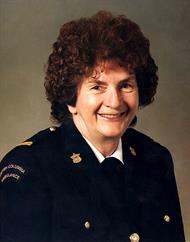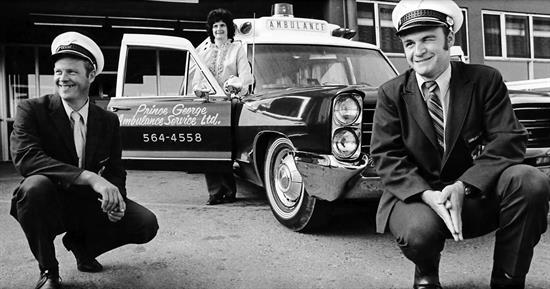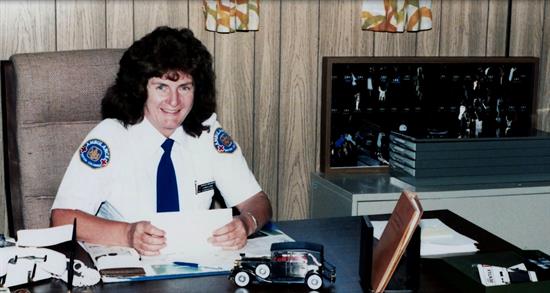Use this image as both the current Page Image and for News listings
by Karla Wilson
Elizabeth Davis, also known as ‘Betty Ann’ or ‘Beth’, was a dedicated paramedic and tenacious leader in British Columbia’s pre-hospital health services sector.
Affectionately dubbed the ‘queen of the north’ by many at BC Emergency Health Services, Davis broke boundaries as a woman in her field. She was instrumental in building our provincial ambulance service in northern B.C. by helping to develop the infrastructure that still stands today.

We recount Elizabeth Davis’ inspiring story below.
---
Elizabeth Davis was born in 1933 in Shaunavon, Saskatchewan. In 1945, her family relocated to a homestead near Myworth, about 11 kilometres from Prince George B.C., where Elizabeth graduated from high school with honours.
As a young woman, Davis rode racehorses. She often felt frustrated with not being able to find immediate, adequate care for the injuries she suffered — so she learned how to tend to her own first aid requirements.
This began Elizabeth’s journey in pre-hospital care.
In 1962, Prince George city employee Chuck Cawdell invited Davis to work for him to form the first official private ambulance service in Prince George. Davis, who was three months pregnant at the time, agreed to the job offer. Soon, a makeshift Prince George ambulance station was set up in her home with a special telephone line installed. Davis would take a call, pick up Mr. Cawdell, and they would attend to emergencies in a 45-horsepower Volkswagen ambulance that “didn’t go very fast,” according to Davis.
Not long after the Prince George ambulance service was formed, Chuck Cawdell died suddenly from a heart attack. Davis’ husband, Herman Penner, stepped in and became her ambulance partner. For years, the ambulance service operated as a private enterprise from their home while Elizabeth and Herman raised their five children. Their company of four full-time and several part-time employees charged patients $1 per call.
Elizabeth and Herman soon realized their Volkswagen ambulance was inadequate for emergency calls, so they custom-ordered a Pontiac Bonneville station wagon from Texas to meet their needs. When the ambulance was built, they travelled to Texas and drove it back to Prince George.
Pictured: Prince George’s Pontiac Bonneville ambulance
 Pictured, L to R: Herman Penner, Elizabeth Davis, Don Schofield
Pictured, L to R: Herman Penner, Elizabeth Davis, Don Schofield
In 1974, the Province of B.C. stepped in to create a provincial ambulance service: BC Ambulance Service (BCAS). Elizabeth was asked to be the first unit chief in charge of the Prince George ambulance station.
“The fact that it was going to be a public service, I would say, was welcome news,” Davis said in a 1996 interview. “If you went into the ambulance business, it was far into the care service business. It was because you cared for people.”
“We operated out of our own houses for a number of years,” Davis continued. “I don't know the exact date that we moved to our first station, but it was a good six years at least.”
Davis became well-known for her tenacity and hands-on leadership style and she quickly moved up the leadership ranks in the new ambulance service. In 1975, she was invited into her next role at BCAS as zone coordinator for the province’s north– a more senior position that encompassed two thirds of B.C.’s geographic area.
 Pictured: Elizabeth Davis in her temporary Prince George office in 1975. A trailer housed the PG dispatch centre, Davis’ office and her secretary
Pictured: Elizabeth Davis in her temporary Prince George office in 1975. A trailer housed the PG dispatch centre, Davis’ office and her secretary
During her 11 years as zone coordinator, Davis grew the number of stations in her region from 22 to 47. While this was a team effort, Davis was no stranger to hard work.
“I washed cars, I put in radios, I took out radios, I measured tires, I put in batteries,” Davis said.
In Williams Lake, Davis worked to renovate an entire building over a long weekend to turn it from a garage into an operational ambulance station by Tuesday morning.
“We had steam cleaned it inside and out. We had painted it. We built a mezzanine in. We put linoleum in. We put floors in. We bought furniture for it. And we put in phones. After that, they had an ambulance station operating — and we did that over a weekend,” she said.
As a first aid instructor for St. John Ambulance, Elizabeth taught both basic and industrial first aid. This training proved useful to new staff of the ambulance service, as she would teach basic first aid to employees as she set up each new station in the north. At the time, this might be the only training they would receive when starting their paramedic careers.
Davis’ travels around the province to help build new stations came with several inherent dangers —like wildlife, weather, and road conditions. She would regularly spend between 14-18 days on work tours of her geographic territory and stations.
“I carried a rifle when I was going to Dease Lake and stuff like that,” Davis said, recalling a time where she encountered two grizzly bears fishing in a river she had to cross with her vehicle. “On the Alaska Highway I got pictures of the highway where the sign says ‘very, very, very, very dangerous curve’. There were four “very’s” in it.”
“I had my suitcase with my nice clothes, and then I had my duffel bag with my survival gear,” she continued. “There were no radios. You couldn’t take your radio because there was [sic] no radios. Who were you going to talk to?”
Known for her positive relationships and pride in her crews, Davis recalled a time in 1974 when she wrote a Christmas message to her staff across northern B.C.
“I said we had huge distances to travel, we had extremely poor equipment – because we did. We were just starting to get things. But there was one thing we had the best of – and that was people.”
In 1985, Elizabeth Davis transferred to Vancouver as a regional superintendent, helping to manage all ambulance stations in that region. In this role, Elizabeth set up and managed the first air evacuation training course for the organization.
Pictured: Winners of the 1990 Pre-Hospital Care Competition held by BCAS.
L to R: Elizabeth Davis, Dwayne Collins, Ted Swan, Jim Ferguson, John Wilcox, Wes Lowenburg, Rene Bernklau, Gerry Harris, Jay Brownlee, and Terry Reid.
Davis kept employees engaged by competing in, coaching, and running pre-hospital care competitions. She would set up mock scenarios, create marking sheets for the judges and manage all operations of the competitions. Davis set up her first competition in Prince George in 1984 and continued them throughout her career.
In June 1994, Davis moved to Kamloops as coordinator of support services for 54 stations located in the Thompson-Okanagan and Kootenay regions. Then, in 1998, Davis had to retire from the ambulance service at the age of 65 due to a legislated maximum retirement age for all British Columbians at the time.
Pictured L to R: Lieutenant Governor of B.C. Garde Gardom and Elizabeth Davis in 1999 at the Emergency Medical Services Exemplary Service Medal awards ceremony.
In December 2023, Elizabeth passed at Royal Inland Hospital in Kamloops. Without a doubt, her name and her legacy live on within BC Emergency Health Services.
At Elizabeth Davis’ celebration of life in August 2024, BCEHS Paramedic Public Information Officer Brian Twaites delivered a eulogy on behalf of Chief Ambulance Officer Leanne Heppell and the BCEHS senior leadership team, marking the respect and admiration of those across the organization who had the opportunity to work with her.
“British Columbia Emergency Health Services is an extended family that reaches far and wide, and we have lost a key member with Elizabeth’s passing,” he said. “She undoubtedly made an indelible mark on the British Columbia Ambulance Service — and many of the people and infrastructure that she helped put in place stands proud to this day.”
Senior Provincial Executive Director Mike Michalko also paid tribute to Davis and her many accomplishments.
“It’s hard to summarize or even understand the impact Elizabeth would have had on so many patients, their families, our communities, her co-workers, her peers, and ultimately friends,” he said. “If we reflect on Elizabeth’s career, the number of people she supported – all I can think about is the care, the kindness, and the professionalism was felt by so many.”
Keith Hale, who was married to Elizabeth for 43 years and worked for BCEHS as a critical care paramedic, echoed his late wife’s dedication to her role and to the organization.
“Elizabeth believed that her employees were the backbone of the ambulance service,” he said. “She worked with them and assisted them in every way she could to make this the best service possible.”
Adored and admired by many, Elizabeth Davis’ legacy and numerous accomplishments have left an indelible mark on BC Emergency Health Services. The organization would not be where it is today without her vision, determination and willingness to work hard at the thing she most believed in: caring for others.
Elizabeth Davis has been laid to rest in Prince George, B.C.

